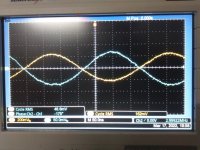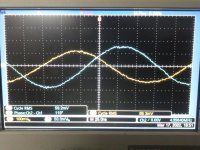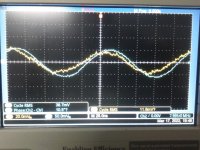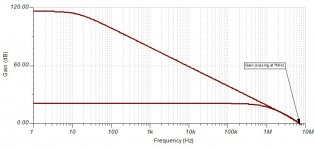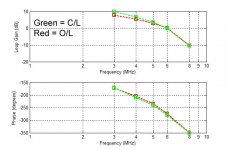I managed to obtain +/-34V power supplies, with a gain of 11V/V (Rf/Ri = 10k/1k). The 220pF capacitor between the inputs was not included in this set of measurements. The input voltage used was also more "small-signal", at around 50mV(RMS). The phase crossing (180*) was at 3MHz (as specified), but with a much higher gain crossing of 6MHz vs. 4MHz as shown in the datasheet. It is thus seen that the LM3886 loop gain is dependent on supply voltage after all, as also correctly mentioned by Tom above.
Nevertheless, it is still worth noting that the phase response doesn't come anywhere close to what the TINA model shows ! With so much phase rotated, it would indeed be very difficult (if not impossible) to arrive at a working composite amplifier, without kind of compensation applied.
Nevertheless, it is still worth noting that the phase response doesn't come anywhere close to what the TINA model shows ! With so much phase rotated, it would indeed be very difficult (if not impossible) to arrive at a working composite amplifier, without kind of compensation applied.
Attachments
Last edited:
According to the TINA model, the gain crossing happens at 7MHz. However, the phase response seems to indicate that the model might be missing a non-dominant pole, as the lag doesn't reach 180*, even at 10MHz. In other words, there is no phase crossing at all !!!
Attachments
Here is an estimation of the open-loop response from the closed-loop response obtained using the pictures in post #21. The amplifier was non-inverting with a gain of 11, or a resistor divider attenuation factor of 1/11.
And as we can see, this is the frequency region where the amplifier runs out of steam, leading to not much of a difference between open-loop and closed-loop gains. Thus, for anyone who wishes to measure the (HF) loop gain of his/her amplifier, the measured closed-loop response (in this crossover region) would be more or less same as the open-loop response, at least for all practical intents and purposes. Further, this seems to be the best one could do without a (vector) network analyser.
And as we can see, this is the frequency region where the amplifier runs out of steam, leading to not much of a difference between open-loop and closed-loop gains. Thus, for anyone who wishes to measure the (HF) loop gain of his/her amplifier, the measured closed-loop response (in this crossover region) would be more or less same as the open-loop response, at least for all practical intents and purposes. Further, this seems to be the best one could do without a (vector) network analyser.
